Are you curious about wood pigeons and want to learn more about these unique creatures? Look no further, because this is the ultimate guide to wood pigeons.
From their physical appearance and behavior to their habitat and diet, we’ve got you covered with everything you need to know.
If you’ve ever wondered about the best ways to spot a wood pigeon in its natural habitat or how they contribute to their ecosystem, this guide will provide all the answers.
We understand your love for birds and want to help satisfy your curiosity about these beautiful creatures.
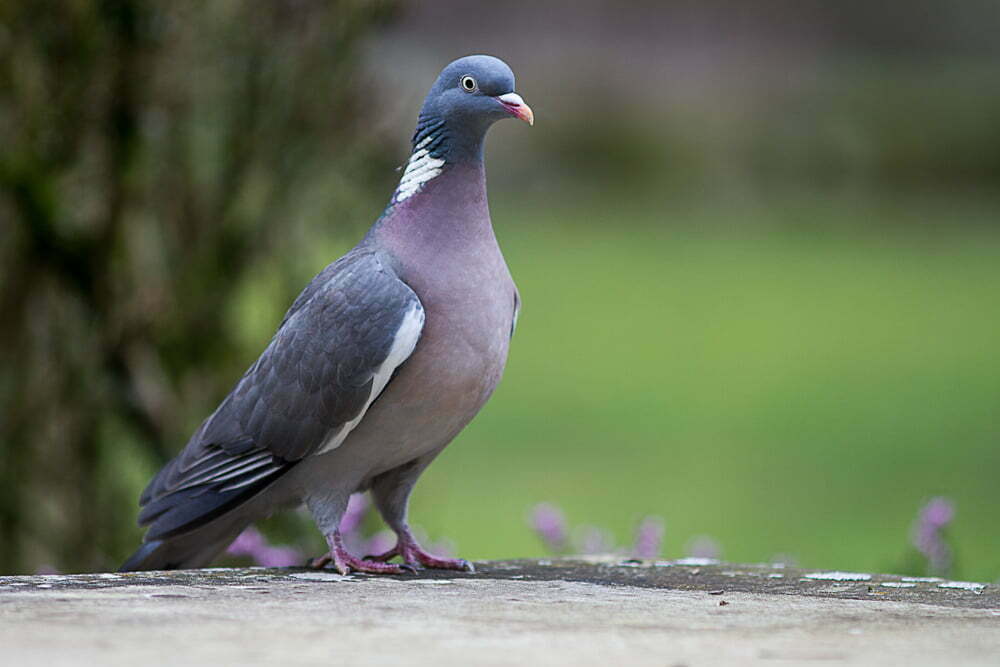
What Is A Wood Pigeon?
A Wood Pigeon (Columba palumbus), distinct from city pigeons, is a common avian species across Europe and parts of Asia. These birds sport a sizeable silhouette, often reaching up to 40 centimeters in length with an expansive wingspan up to 80 centimeters.
Characteristics:
- Size: Adult wood pigeons are notably plump with a round body and a relatively short neck.
- Weight: They weigh between 300 and 600 grams.
- Plumage: Their plumage predominantly features shades of dark grey. Adults have notable white patches on their wings and neck, often outlined with touches of green iridescence.
- Song: Distinguishable by their low, growling coos and calls, adding to their unique charm.
In your garden or local woodland, you can identify these birds by their notable neck patches and white wing bars observable in flight.
Unlike domestic pigeons, wood pigeons show a preference for rural and semi-urban environments.
Their diet is largely herbivorous, feasting primarily on seeds, shoots, and leaves, which unfortunately for farmers, can include cereal crops.
Your recognition of these birds can be aided by their flying pattern; wood pigeons display a characteristic steady beat of wings, interspersed with glides, accentuating their broad wing bands.
These traits combine to make the wood pigeon a familiar yet impressive presence in its natural habitat.
Key Differences Between a Female Wood Pigeon and A Male Wood Pigeon
When observing wood pigeons, telling apart a female from a male can be subtle, yet with careful attention, you can spot consistent distinctions:
Physical Appearance:
- Size: Males generally exhibit a larger body size compared to females, with this difference being more pronounced in their longer tails and wingspans.
- Head Shape: Males have a more pronounced and sharply rounded head, while females display a smoother, gently rounded head.
- Plumage Color: The male wood pigeon boasts brighter plumage, characterized by more vivid and contrasting colors on their chests and necks, as opposed to the female’s duller brown coloring.
Behavioral Traits:
- Courtship: You may notice males engaging in showy courtship behaviors, puffing up their chests and strutting around females.
| Male Wood Pigeon | Female Wood Pigeon |
|---|---|
| Larger in size | Smaller compared to males |
| Sharply rounded head | Softer, smoother head |
| Brighter, contrasting plumage | Duller brown plumage |
| Pronounced courtship behavior | Less showy behavior |
Remember that these are general indicators and there might be variations within individual birds.
Observing them side-by-side can often provide clearer comparative context, as the difference in size and plumage may be easier to discern.
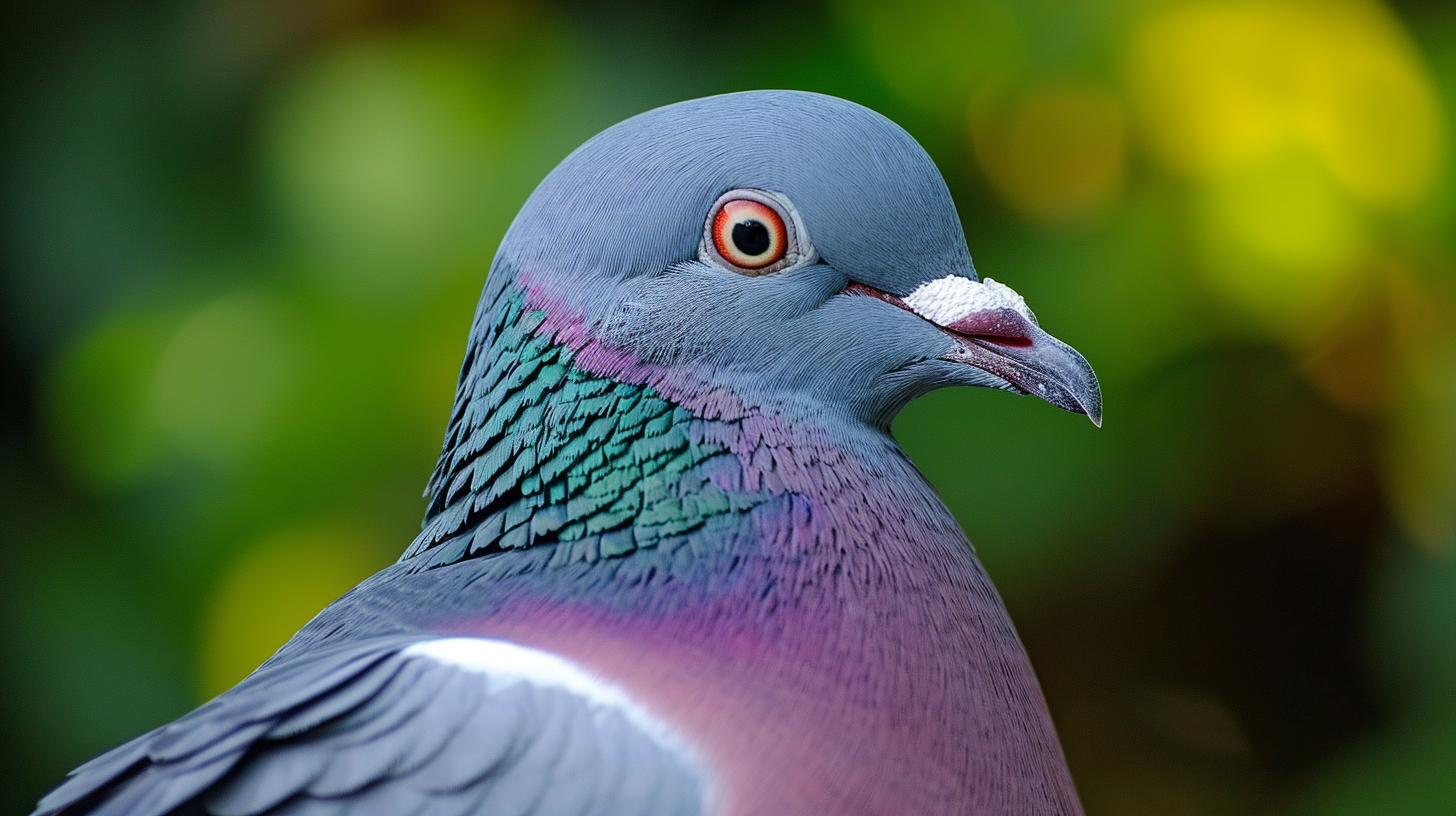
What Do Wood Pigeons Look Like?
Wood pigeons (Columba palumbus) are distinguishable by their sizeable, robust bodies which typically measure 38-44.5 cm in length with a wingspan of 68-80 cm.
Your observation will reveal that their plumage is predominantly gray.
Here are the key features to note:
- Head: Small in relation to the body with a distinctive white patch on the side of the neck.
- Chest: A prominent white patch contrasts with their otherwise gray bodies.
- Wings: Black wingtips with a white wing bar are visible, especially during flight.
- Eyes: They have bright, round eyes that give them a keen look.
- Beak: Short and pinkish with a white cere (the soft, fleshy swelling at the base of the beak).
Their subtle color palette includes shades of gray and lilac, with the adult birds showcasing iridescent green and purple patches around the neck.ummies.
When you spot a wood pigeon, you’ll likely see:
- Soft, gray feathers over most of the body.
- Darker wingtips with distinctive white markings.
- A patch of white on the neck, sometimes framed with attractive greenish iridescence.
This description should aid in the identification of wood pigeons, whether they are perched conspicuously in a tree or observed in flight displaying their striking wing patterns.
What Does a Wood Piegon Fledgling Look Like?
As you observe wood pigeon fledglings, you’ll notice they exhibit specific characteristics distinct from their adult counterparts. Understanding these features helps in identifying them in their natural habitat.
- Feather Coloration: Fledglings possess paler plumage compared to adults. The typical greys are lighter, and the characteristic white patches are not yet visible.
- Neck Band: Unlike adults, fledgling wood pigeons have not developed the notable white neck band. This feature will emerge as they mature.
- Eyes: The eye color of a fledgling wood pigeon is often a darker blue, transitioning to the adult’s bright color in time. Moreover, the pupil shape is oval, which differs from the rounded ones observed in mature wood pigeons.
- Size and Posture: Fledglings are usually smaller, with a plumper and less sleek body shape. Their posture may also appear less confident as they are still mastering coordination and balance.
Nestling Period: Understanding the stages of their growth is important to identify a fledgling accurately. Initially, wood pigeons stay in the nest for up to 29 days post-hatching, developing essential feathers and muscles.
Remember, juvenile wood pigeon identification requires attention to these subtle yet distinct features.
Observing them in their natural setting can be a rewarding experience as you watch these young birds gain the characteristics of the striking adults they will become.

What’s the Difference Between a Wood Pigeon and A Collared Dove?
When distinguishing between a Wood Pigeon and a Collared Dove, certain physical and behavioral characteristics are noticeable.
Size and Appearance:
- Wood Pigeon: Larger in size, displaying a robust body, long tail, and broad wings. Males often have a bright plumage with contrasting colors, while females present a more muted brown with white wing patches.
- Collared Dove: Smaller and more delicate with a distinctive black half-collar on the nape of the neck. It has a uniform light gray to pinkish-gray body and a shorter tail compared to the Wood Pigeon.
Song:
- Wood Pigeon: You can recognize their song by a repetitive five-syllable cooing, which is deeper and has a rhythmic pattern.
- Collared Dove: Their song consists of a three-syllable coo, which is softer and more consistent in tone.
Here’s a side-by-side comparison for clarity:
| Feature | Wood Pigeon | Collared Dove |
|---|---|---|
| Size | Larger; robust body | Smaller; more delicate |
| Tail | Long | Shorter |
| Wing Patches | Yes, in males (bright plumage) | No distinct wing patches |
| Neck Collar | No | Yes, distinct black half-collar |
| Song Pattern | Five-syllable deep cooing | Three-syllable soft coo |
Where Do Wood Pigeons Live?
Wood pigeons, known scientifically as Columba palumbus, inhabit a broad range of environments across Europe, Asia, and North Africa.
You will commonly find them thriving in both wooded and forested areas. These birds have adapted well to diverse living conditions, from the countryside to urban landscapes such as city parks.
The habitat preferences of wood pigeons include:
- Deciduous and mixed forests
- Farmlands
- Plantations
- Gardens
- Urban parks
It is notable that in urban settings, wood pigeons have shown remarkable adaptability. Your encounter with them in city parks and other green urban spaces would not be uncommon.
In rural areas, wood pigeons are frequently regarded as agricultural pests. They consume a variety of crops, prominently grains like wheat, barley, and oats.
Despite this, their presence in the ecosystem plays a pivotal role, and in some regions, they are also valued as game birds.
Here’s a quick summary of their geographical distribution:
- Europe: Widespread and common
- Asia: Varied presence depending on the region
- North Africa: Present in areas that provide suitable habitats
Their successful adaptation to different habitats highlights the versatility of wood pigeons in finding suitable nesting locations and food sources.
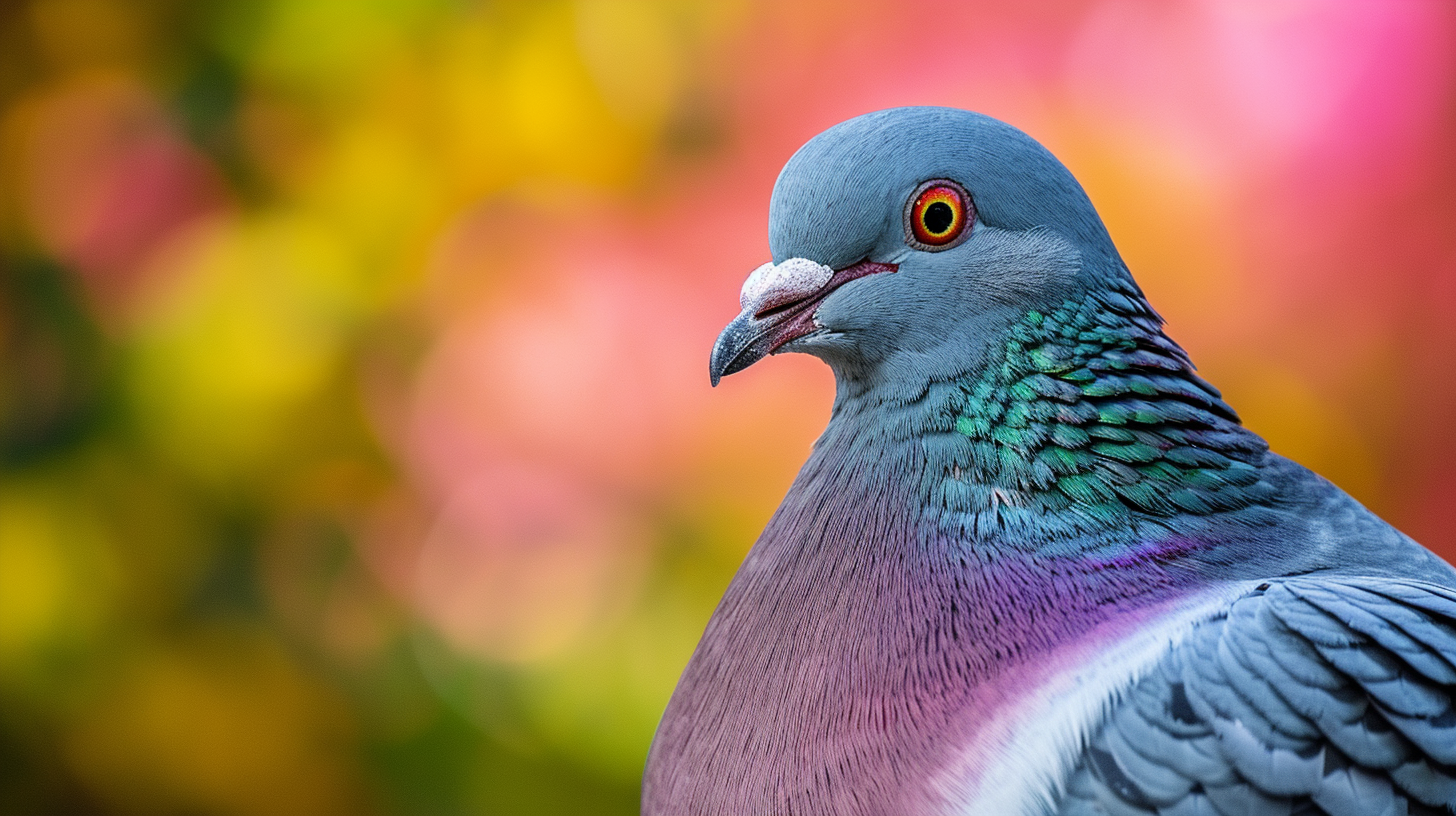
Why Are Wood Pigeons so Noisy?
Wood pigeons are known for their distinct and often loud cooing sounds. Your curiosity about their noise levels can be attributed to several factors:
Communication: Primarily, wood pigeons use their cooing to communicate. The cooing serves various purposes, including attracting mates during the breeding season and signaling danger.
Breeding Behavior: Males typically produce a louder coo to showcase their health and fitness to potential mates. The intensity and volume of their cooing can influence their success in finding a partner.
- Alert System: Wood pigeons coo to alert other pigeons of potential threats. This can result in a chain reaction of noise as the warning spreads.
- Territorial Calls: When defending territory, wood pigeons become more vocal. Loud cooing helps in asserting their presence and deterring rivals.
Physiology: Your understanding of their noisiness is also tied to their physical build. Wood pigeons have a robust syrinx, the vocal organ of birds, which enables them to produce strong, resonant sounds.
Note these characteristics:
| Feature | Impact on Noisiness |
|---|---|
| Large syrinx | Amplifies sound |
| Vigorous wing beats | Creates additional noise |
| Echoing in urban areas | Augments perceived volume |
What Kind of Nest Does a Wood Pigeon Have?
Wood pigeons create nests that are distinct in their simplicity. When you observe these nests, you’ll notice they are generally made from a collection of twigs.
These twigs are assembled into a platform shape, which serves as the foundation for the nest.
The construction process is a joint effort, with both the male and female wood pigeon contributing to the building of their shared home.
- Location: You’ll find wood pigeon nests in a variety of settings, from the classic woodland environments to urban areas, such as in city parks or gardens.
- Reusability: These birds often display loyalty to their nesting sites, opting to reuse and reinforce their nests for multiple breeding cycles.
- Maintenance: Both the male and female pigeons take part in maintaining the nest, ensuring its stability and readiness for the eggs and eventual squabs.
The nests are typically positioned in trees or shrubs. There isn’t a great deal of intricacy in the nest’s design, but it is functional enough to serve its purpose.
A wood pigeon’s nest might not be architecturally complex, but its efficacy is evidenced by the species’ widespread numbers and successful rearing of chicks.
In these nests, the wood pigeon will lay their eggs and care for their squabs. The young are fed a special substance known as “Pigeon milk,” which is rich in proteins and fats, produced by both parents.
This ensures the squabs receive the essential nutrients necessary for their development during the early stages of their life.

How Many Eggs Does a Wood Pigeon Lay?
When you observe the reproductive habits of wood pigeons, you’ll note that the typical clutch size is two eggs.
After mating, a female wood pigeon will lay her first egg, usually within 10 to 14 days, often during the early evening. The second egg follows about 44 hours after the first.
These eggs are relatively uniform in appearance—plain white and approximately 4 cm in size.
It is more common for wood pigeons to lay two eggs, but there are instances where a very young or older female might lay only one.
Consider the following details about the nesting and egg-laying process of wood pigeons:
- Nesting Site: Preferring trees, especially large deciduous ones, wood pigeons create nests in woodland areas and hedges.
- Nest Composition: Their nests are made from a simple structure of loose twigs.
- Egg Appearance: The eggs are plain white without any markings.
Keep in mind that the overall success of the nesting and the number of eggs laid can be influenced by factors such as the age of the pigeons and environmental conditions.
However, you’re most likely to encounter a pair of these plain white eggs in a wood pigeon nest tucked away in a tree or hedge.
When Do Wood Pigeon Eggs Hatch?
When you’re observing the breeding cycle of wood pigeons, understanding the hatching timeline of their eggs is essential
A wood pigeon egg typically hatches after 17 to 19 days of incubation, with the average being around the 18th day.
Here’s a brief overview to help you track this period:
- Incubation Start: Once both eggs are laid (wood pigeons typically lay two eggs).
- Average Incubation Period: 18 days.
- Hatching Window: Between 17 and 19 days after incubation starts.
During incubation, both parents take turns keeping the eggs warm. If you’re nurturing wood pigeon eggs, maintaining a consistent and suitable environment is vital for successful hatching.
Remember, you should rarely handle the eggs and only do so with clean hands to prevent contamination and the spread of bacteria.
Regularly check the eggs during the incubation period without disturbing the parents too much. As the hatching date approaches, you might notice small changes as the chick prepares to break through the shell.
Important Reminders:
- Cleanliness: Keep the nesting area clean to reduce health risks.
- Disturbance: Minimize intrusion to avoid stressing the parents.
- Temperature: Ensure eggs are incubated at a steady temperature.
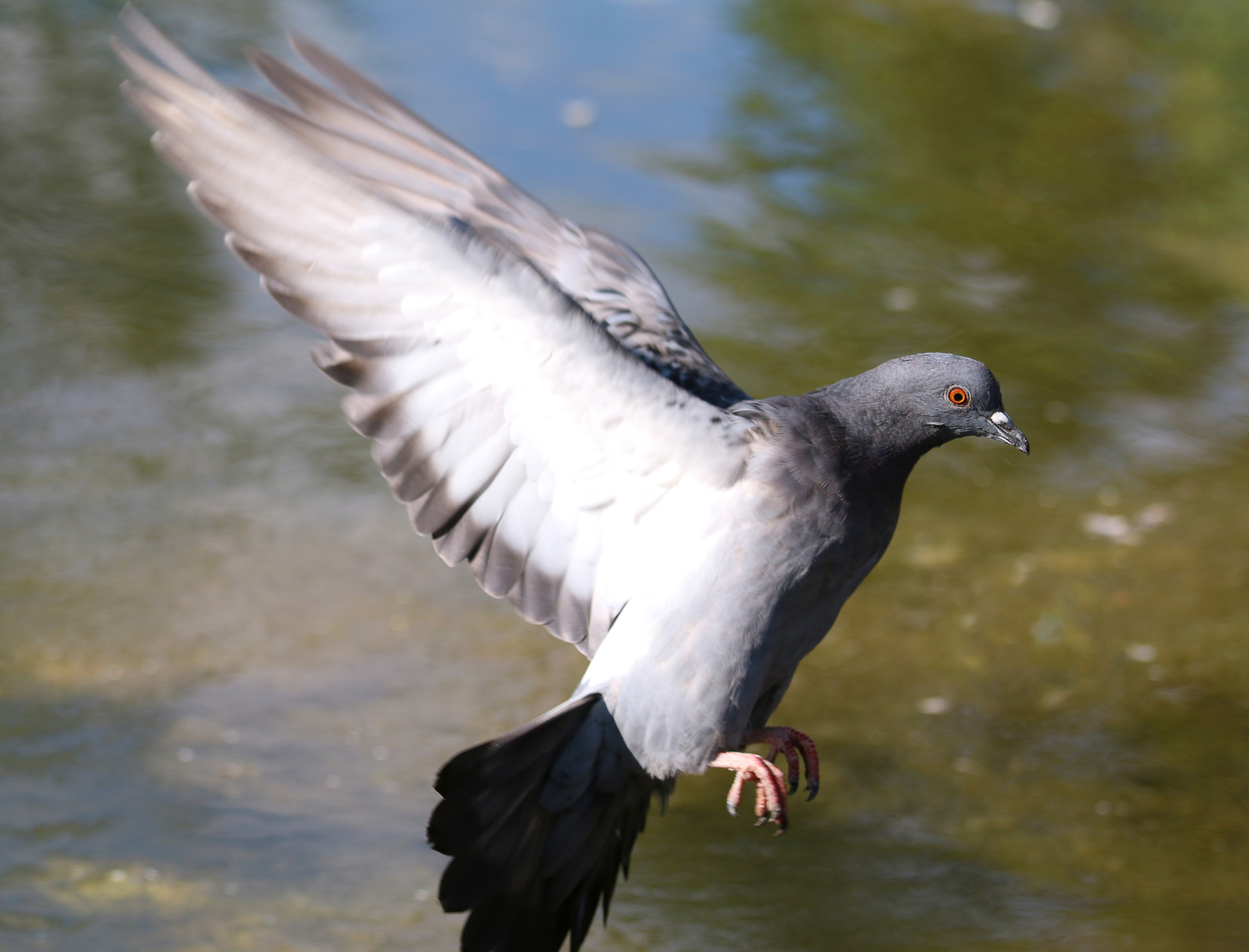
What Is the Wingspan of A Wood Pigeon?
When observing the common wood pigeon (Columba palumbus), you’ll notice its sizeable wingspan as a distinctive feature.
The wingspan of these birds is typically in the range of 68 to 80 cm. This measurement is critical as it provides insights into their flying capabilities and aerial maneuverability.
Key Measurements:
- Minimum Wingspan: 68 cm
- Maximum Wingspan: 80 cm
Wood pigeons display their impressive span when in flight, which aids in their ability to glide and soar through their habitat. Their wings are also adapted for rapid flight when escaping predators.
Your observation of the wood pigeon in flight will reveal not just the breadth of their wings but also the bird’s control and fineship over its large wingspan.
Despite their robust build, wood pigeons are quite graceful in the air, using their wings to effectively navigate and forage for food across varied landscapes.
Life Expectancy of A Wood Pigeon
On average, wood pigeons live for around 3 to 5 years. However, it’s noted that in more favorable conditions, some individuals may reach an age of up to 6 years.
Several studies indicate that while the average lifespan tends to be on the lower end, there are cases of these birds living significantly longer.
Factors influencing their lifespan include:
- Predation: Younger birds and eggs are susceptible to predators.
- Disease: As with any wildlife, disease can shorten their life expectancy.
- Human activity: Urbanization and farming can impact their lifespan both positively and negatively.
Their ability to breed all year round ensures a steady population, despite their relatively short life span compared to other birds of their size.
The common wood pigeon’s successful adaptation to urban and rural habitats alike contributes to their resilience as a species.
| Age Milestones | Description |
|---|---|
| 0-1 Year | Youth; high mortality due to predation and disease. |
| 1-3 Years | Prime breeding age; majority of living population. |
| 3-6 Years | Older individuals; less common due to natural causes. |
You should note that individual lifespans vary greatly, and wood pigeons can occasionally surpass these typical age ranges, especially in less hostile environments or with a plentiful food supply.

What Kind of Damage Can Wood Pigeons Cause to Your Property or Garden Plants?
Wood pigeons can be beautiful additions to your local wildlife, but they can also be quite problematic for gardeners and property owners.
These birds tend to feed on a variety of plants, and their dietary choices can lead to significant damage if not addressed.
Young Plants:
- Wood pigeons gravitate towards young, tender seedlings and saplings. They may uproot these entirely or eat the buds, disabling the plant’s ability to grow.
Leafy Greens:
- Your vegetable patch may suffer, as these pigeons have a particular appetite for leafy greens. You may notice holes in leaves or complete absence of younger shoots.
Fruit Damage:
- If you grow fruit, be aware that wood pigeons may peck at these. They don’t just consume the fruits; they may also damage the plant itself, affecting future yields.
Garden Aesthetics:
- Beyond eating plants, the presence of wood pigeons can disrupt the overall aesthetic of your garden. Droppings can be unsightly and may pose hygiene concerns if not cleaned up regularly.
How Can You Deter Wood Pigeons from Nesting in Your Backyard or On Your Roof Top?
Wood pigeons are attracted to gardens and other green spaces because they provide an abundance of food and places to build their nests. Unfortunately, these same qualities make wood pigeons a nuisance for many homeowners.
If you’re dealing with wood pigeons nesting in your backyard or on your roof, there are a few things you can do to deter them. First, remove any sources of food that may be attracting them, such as bird feeders or standing water.
Second, make sure that there are no places for them to build their nests by trimming trees and shrubs and keeping your yard clean. Some people use parallel wires as a deterrent, helping to protect crops or seedlings.
Finally, you can try using visual deterrents as a pigeon control method, such as plastic owls or shiny objects, to scare the birds away. By taking these steps, you can help to keep wood pigeons out of your yard for good.
What Does Wood Pigeon Poo Look Like?
Wood pigeon poo is dark green and glossy in appearance, and is usually deposited in small, neat piles. The main component of wood pigeon poo is undigested seeds, which can be harmful to plants if left uncollected.
Wood pigeon poo is also a favourite food source for slugs and other garden pests, so it’s important to remove it from your garden as soon as possible.
If you have a problem with wood pigeons roosting in your garden, consider using a bird net to deter them. By preventing wood pigeons from accessing your garden, you can help to protect your plants from potential damage.
How Do You Safely Get Rid of Wood Pigeons?
To manage wood pigeons in your area without harm, follow these methods:
- Eliminate Food Sources: Ensure that your outdoor space is free of accessible food. Regularly clean to remove fallen seeds from bird feeders, and secure trash cans to dissuade pigeons from foraging.
- Use Deterrents:
- Visual: Install reflective tapes or discs. Their movement and reflection can scare pigeons away.
- Physical: Set up bird spikes or netting in roosting areas to prevent pigeons from landing.
- Sound Devices: An ultrasonic bird repeller can emit sounds that are inaudible to humans but can deter pigeons.
- Decoy Predators: Place figures representing hawks or owls around your property. These can act as a natural deterrent because wood pigeons are afraid of predators.
- Professional Services: If the infestation is substantial, a professional pest control service can employ safe and humane methods using a combination of spikes, netting, and other deterrents.
When implementing these measures, always maintain a humane approach. Check local laws and regulations regarding bird control as wood pigeons may be protected under wildlife conservation acts.

Do Wood Pigeons Carry Diseases?
Wood pigeons carry a range of diseases. Key among these are viruses, with research identifying some that belong to the Astroviridae family.
While it’s noteworthy that wood pigeons can harbor diseases, it’s also crucial to understand the nuances of transmission.
- Viruses: Although specific varieties have been identified in wood pigeons, these do not typically transfer to humans.
- Bacteria: Pigeons can carry E. coli, which under certain circumstances, might pose a risk to human health.
- Fungal Infections: Diseases like Histoplasmosis are associated with pigeon droppings, especially in places with large accumulations of droppings.
Your chances of contracting a disease from wood pigeons are generally low. Pigeons often become a vector through their droppings or parasites they carry.
However, the direct transmission of diseases from these birds to humans is relatively rare. Here’s a concise breakdown:
- Pigeon Droppings: Can contain pathogens. Risk increases with close and frequent contact.
- Parasites: Mites and fleas found on pigeons can occasionally transfer to humans.
To minimize your risk:
- Avoid direct contact with pigeons and their droppings.
- Practice good hygiene, particularly washing your hands after any potential contact.
- Employ control measures if pigeons are a persistent problem near your living or work space, such as netting or spikes.
Why Do Wood Pigeons Fight?
When observing wood pigeons, you’ll notice they sometimes engage in physical confrontations. These conflicts arise for a few fundamental reasons:
- Territory Disputes: Like many other birds, wood pigeons are territorial. They use fighting to defend their nesting and feeding areas from others. Your garden may become a battleground if it provides a good food source or nesting site.
- Mating Rights: During breeding season, male pigeons will often fight to prove their dominance and win over a mate. By establishing superiority, a male pigeon ensures that its genes are passed on to the next generation.
- Access to Food Resources: Food is a motivator for many animal behaviors. Wood pigeons compete for food, especially in areas where it is scarce, and these competitions can lead to fights.
These behaviors are natural and essential for the survival of wood pigeons. They communicate through their aggressive actions, establish hierarchies, and ensure that the fittest pass on their genes.
If you’re witnessing these fights, avoid intervening, as they are a typical aspect of wood pigeon life. Instead, appreciate the complexity of their social structures and survival tactics.
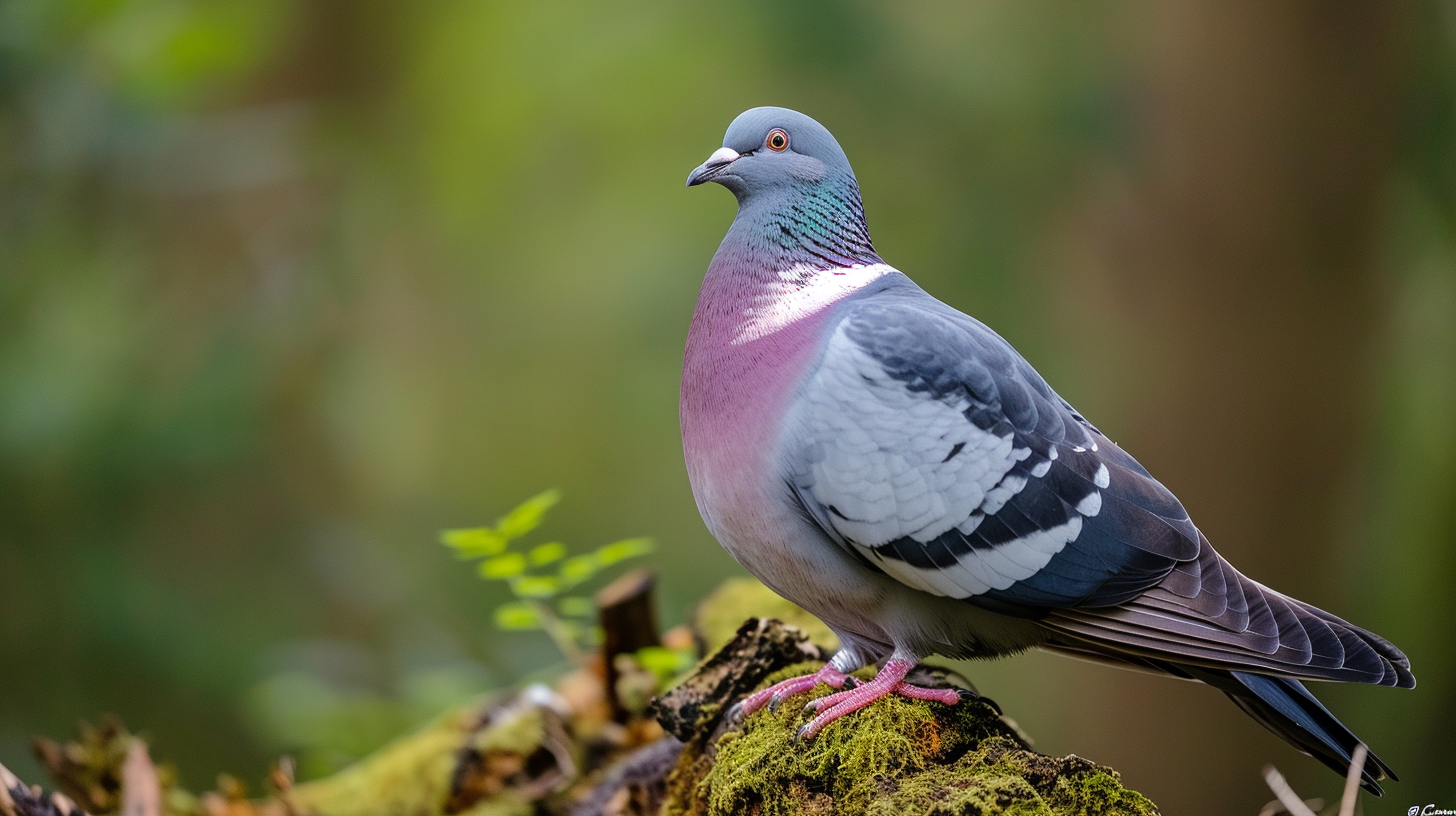
Are Wood Pigeons Protected?
In the United Kingdom, wood pigeons enjoy protection under the Wildlife and Countryside Act 1981. It is illegal to:
- Intentionally kill
- Injure
- Take a wood pigeon
Engaging in activities like shooting, trapping, or employing live decoys without proper authorization is a violation of the law. Offenders may face significant fines or imprisonment.
However, there’s a nuance to this protection. There are situations wherein control under license is permitted, often to prevent serious damage to crops. Ensure to verify current legislation or guidance from wildlife authorities before taking any action.
In the United States, the situation differs. Wood pigeons, also known as common wood pigeons, are not native to the U.S. and typically fall under the same category as feral pigeons.
They are not federally protected and are treated as an invasive species with lesser restrictions. Still, it’s wise to check state-specific regulations as local laws may offer some level of protection or control guidelines.
Can You Have a Wood Pigeon as A Pet?
While wood pigeons (Columba palumbus) are a common sight in many parts of Europe, found in woodlands, parks, and gardens, they are not typically domesticated as pets.
In contrast to domestic pigeons, which have been bred for a variety of uses and companionship, wood pigeons are wild birds, and keeping one as a pet would require consideration of several factors.
Firstly, you should check your local wildlife regulations. In many places, it is illegal to keep native wild birds as pets without a proper license or permit.
Wood pigeons are also protected under wildlife conservation laws in some countries, making it unlawful to remove them from their natural habitat.
If legal in your area, here’s what you might need to consider:
| Consideration | Description |
|---|---|
| Housing | Wood pigeons would require substantial space to fly. Your enclosure should mimic their natural environment as much as possible. |
| Diet | They have specific dietary needs that must be met with a mix of seeds, grains, and greens similar to their diet in the wild. |
| Healthcare | You need access to avian veterinarians for health issues and advice on keeping a wood pigeon in optimal health. |
| Social Needs | They are social creatures and may not thrive in isolation. Consider the bird’s wellbeing if you’re thinking of keeping one alone. |
| Time and Effort | Wild birds demand considerable time and dedication for care, feeding, and cleaning. The commitment is long-term, often for years. |
Considering these points, it’s evident that wood pigeons are not the ideal pet choice for most people. It’s typically more appropriate and enriching to enjoy these birds in their natural habitat rather than as a household pet.
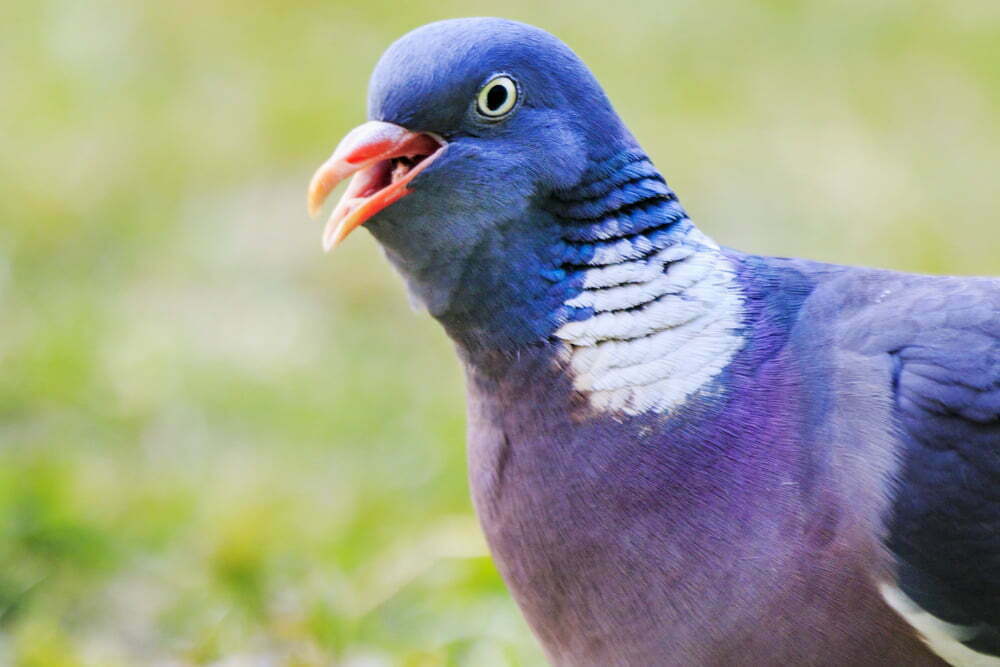
What Can You Do in Your Garden to Encourage Wood Pigeons Visiting Your Bird Table?
Wood pigeons are one of the most common bird species in the UK, and they are a regular sight in gardens up and down the country. These large birds are particularly fond of sunflower seeds, so if you’re looking to encourage wood pigeons to visit your bird table, then sunflower seeds are a good place to start.
You can also try offering other bird food such as cracked corn, peanuts, and fruit. Wood pigeons are also attracted to water, so placing a bird bath in your garden with fresh water is another good way to encourage them to visit. By taking these simple steps, you can soon turn your garden into a haven for wood pigeons.
Why Do Some People See Wood Pigeons as Being Pest Birds?
Wood pigeons are a common sight in gardens and woodlands, but not everyone sees them as a welcome addition. These birds are relatively large, and their appetite for fruits and vegetables can make them a nuisance to gardeners.
In addition, their nesting habits can cause problems for property owners. Wood pigeons build their nests in trees, and the weight of the nests can cause branches to break. In some cases, the nests can even damage building roofs.
As a result, it is not surprising that some people see wood pigeons as being pest birds. However, these birds also play an important role in the ecosystem, and they are a valuable food source for many animals.
For these reasons, it is important to try to find a balance between controlling wood pigeon populations and protecting the common wood pigeon.
What Is a Group of Pigeons Called?
A group of pigeons is also called a “flock” or a “girdle.” Pigeons are social creatures and often flock together in large numbers. In addition to flocking for safety in numbers, pigeons also flock together to mate. Males will often try to attract females by doing things like bowing, cooing, and strutting around with their tails spread.
If a female is interested, she will return the male’s advances and the two will mate. Once they have mated, the pair will usually stay together for life. Pigeons typically lay two eggs at a time, which both parents help to incubate.
After about 18 days, the eggs hatch and the young pigeons, called squabs, are born. The squabs grow quickly and are usually ready to leave the nest after just a few weeks. At that point, they join a flock of their own and begin the cycle anew.
Do Magpies Kill Pigeons?
While it is commonly believed that magpies kill pigeons, there is actually no evidence to support this claim. In fact, the two birds are often seen coexisting peacefully in urban environments. However, there are a few theories as to why people believe that magpies kill pigeons.
One possibility is that magpies are simply misunderstood; they are known to eat small birds, so it is easy to assume that they might also kill larger birds like pigeons. Another possibility is that people confuse dead pigeons with dead magpies.
Magpies and pigeons share similar coloring, so it can be difficult to tell them apart. Finally, it is also possible that some magpies do kill pigeons, but this is likely to be rare and isolated instances rather than a widespread phenomenon.
How Long Can a Pigeon Survive without Food?
A pigeon can go without food for up to three days, but will start to experience health problems after that point. Pigeons need a steady diet of seeds and grains in order to stay healthy, and going without food for too long can lead to malnutrition. Malnourished pigeons may have trouble flying, and may eventually die if they are unable to find food.
In addition, pigeons rely on water to help them digest their food, so they will also start to experience problems if they do not have access to fresh water.
While a pigeon can technically survive without food for several days, it is not a good idea to allow them to go without food or water for too long.
Wood pigeons are a common sight in many parts of the world. These birds are generally harmless, but can carry diseases that can be harmful to humans and animals. Wood pigeons are also known to fight with other pigeons during the breeding season.
